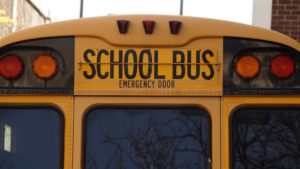Tips For Preparing Your Child To Ride the School Bus
by Beth
I am pleased to have Dr. Judy Shanley here with a guest post today. Judy is the Assistant Vice President of Education & Youth Transition here at Easterseals.
by Dr. Judy Shanley
 Travel via school bus and school transportation involves much more than just being on the bus. It also involves getting to the bus, getting on the bus, getting off the bus and then getting from the bus to the school building. The National Association for Pupil Transportation provides supports regarding school bus safety. Each state has a chapter with its own unique activities, and you can learn about school bus resources in your state and community by contacting your state affiliate. In the meantime, here are some tips to help school bus riders wherever they live in the United States:
Travel via school bus and school transportation involves much more than just being on the bus. It also involves getting to the bus, getting on the bus, getting off the bus and then getting from the bus to the school building. The National Association for Pupil Transportation provides supports regarding school bus safety. Each state has a chapter with its own unique activities, and you can learn about school bus resources in your state and community by contacting your state affiliate. In the meantime, here are some tips to help school bus riders wherever they live in the United States:
- Contact your school district to see if they offer support programs where parents/children can come to the school to tour a bus before the service starts at the beginning of a school year.
- Help your child understand and prepare for social situations on a school bus such as sitting next to classmates and responding to driver directions.
- Encourage your child to travel with a bus buddy, such as a sibling or peer. Consider setting up chairs in the living room to mimic a school bus (have a bus driver, have children sitting in seats imitating behaviors that a child might see, and so on) so the child can learn how to react in these situations.
- Encourage your child to contact you when they arrive safely at school, especially if you have concerns about their independent travel.
- Learn whether your school’s pupil transportation service has a bus tracking service so you can monitor the status of your child’s school bus as it travels to and from the school building.
Parents who think their child might need accommodations or specialized supports for school transportation (funded under IDEA) will need to speak with special education professionals to determine whether it is appropriate to have a travel/mobility assessment. When a range of transportation options are available, I recommend parents consider the option that enables students to travel with their peers (with and without disabilities) in the least restrictive mode. Some school districts even have public transportation service available. For some students, this is an appropriate option.
And guess what? Many parents are considering developing new ride-sharing programs to support travel to after-school and community activities — kind of like Uber for kids. Programs such as Zemcar in the Northeast and HopSkip/Drive in California are programs started by parents that provide an alternative to traditional pupil or public transportation services.
Some of you reading this blog post are starting to think about your child’s transition to post-high school settings. For others, this new school year may mark the first time your child is traveling independently. Take advantage of resources and supports that your school district and others provide and use this opportunity as a teaching moment — you’ll be setting the foundation for future independent travel. By starting your child on a path to independent travel now, they’ll end up in a place where mobility won’t impede their success in any setting.






